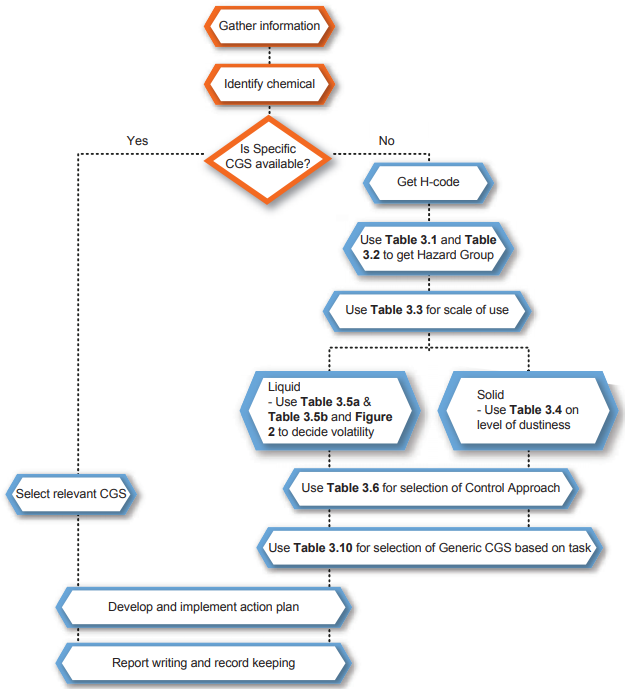“Manual on Simple Risk Assessment and Control for Chemicals (SiRAC) 2019” was released in Malaysia. This manual provides details of employers’ duties under Regulation 9 (assessment of risk to health for workers exposed to chemicals) of the “Occupational Safety and Health (Use and Standard of Exposure of Chemicals Hazardous to Health) Regulations 2000”, specifically stipulating the targets, procedures and methods for simple risk assessment and control for chemicals (SiRAC). SiRAC applies only to chemicals hazardous to health in solid and liquid forms that are supplied for use at the workplace. Typical examples are powder coatings, degreasing solvents, cleaning products, varnishes, ink, paints and chemicals for making into other products.
The original text of this manual can be downloaded from the following URL.
https://www.dosh.gov.my/index.php/legislation/guidelines/chemical/3337-manual-on-simple-risk-assessment-and-control-for-chemicals-sirac-2019/file
Flow to conduct SiRAC
The flow to conduct SiRAC, which is the main theme of this manual, is as shown in the figure below.

In the first step, “Gather Information”, information regarding chemical register, SDS, label, information about the task where chemical is used and total duration of use, existing control measures (such as general ventilation), and other data (such as layout plan, process flow and number of workers exposed to chemical) is investigated. Subsequently, identify the actual work area/process using chemicals and select a task to be assessed. Record the information obtained from these results in accordance with the form SA 2a of this manual.
Secondly, check the hazard classification and relevant hazard statements from SDS of each chemical and obtain H-codes. Determine the hazard groups (four groups of A, B, C and D) using Table 3.1 of this manual based on the H-codes. If there are several H-codes which appear in different hazard groups, select the strictest group (A is the most lenient and D is the strictest). Record the hazard groups of each chemical in accordance with the form SA 2b of this manual.
Determine the scale of use by using Table 3.3, based on the amount of chemical used per operation or batch or a day (in the case of continuous process). The scale of use can be classified into Small, Medium or Large. The largest category must be selected if the amount is not clear. Furthermore, the volatility in case of liquid form, and the level of dustiness in case of solid form must be identified.
Identify the Control Approaches from 1-4 in accordance with Table 3.6 based on the information of “hazard group”, “scale of use” and “volatility or level of dustiness” obtained above.
Control Approach 1 General Ventilation
Control Approach 2 Engineering Control
Control Approach 3 Containment
Control Approach 4 Special
Therein, select task-specific “Control Guidance Sheet (CGS)” stipulated in Table 3.10.
All sorts of records on SiRAC are treated as important documents that indicate compliance with “Occupational Safety and Health (Use and Standard of Exposure of Chemicals Hazardous to Health) Regulations 2000” which is superordinate law of SiRAC, and must be maintained for at least 30 years.
Control Guidance Sheet (CGS)
Control Guidance Sheet (CGS) on this manual can be divided into “Generic CGS” and “Specific CGS”. The former Generic CGS is finely classified in accordance with information such as characteristics of chemicals as described above, but the latter Specific CGS provides fixed CGS for operations in three fields of “Pest control”, “Cleaning services” and “Lithography printing”. For example, cleaning services are further classified into C001 to C006, and details on storage of chemicals for C006 are provided as follows.
 Manual on simple risk assessment of chemicals in the workplace
Manual on simple risk assessment of chemicals in the workplace 

























